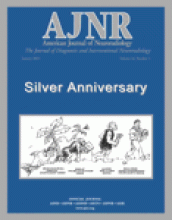Wintermark et al (1) recently reported findings of high signal intensity on T1-weighted MR images and faint hyperattenuation of involved putamen on CT scans one month later. In addition, the putamen appeared hyperintense on the exponential diffusion-weighted (DW) images. The authors tried to propose an explanation by assuming that protein desiccation occurring in the course of Wallerian degeneration could explain the CT hyperattenuation and the MR imaging and DW imaging patterns in the early phase. I think this explanation is inadequate.
First, I had previously reported 10 cases of hemichorea-hemiballism with similar CT and MR imaging findings and collected 13 more cases to date (2). A key finding in my article was that there was a mismatch between the size of lesions detected on CT scans and on T1-weighted MR images, and also a mismatch between their evolutions over time. It appeared that the lesions on CT and on T1-weighted MR images resulted from two different pathophysiological mechanisms running in parallel. It is not appropriate to make an attempt to give one explanation for two pathologic processes, although they may be triggered by the same event.
Second, it is now clear that the high signal intensity lesions on T1-weighted MR images are related to manganese accumulation in the reactive astrocytes after ischemia. In their article published in 1999, Fujioka et al (3) reproduced the MR imaging finding in rats 7 days after 15-minute occlusion of the middle cerebral artery but not after 60-minute occlusion. Histologic examination revealed that this specific ischemic change disclosed by MR imaging corresponded to selective neuronal death and gliosis, with preservation of the macroscopic structure of the brain, a finding similar to what I reported after histologic analysis of a biopsy specimen obtained from my patient. We both agreed that the MR imaging finding resulted from a progressive pathologic reaction in an incomplete infarction, which confirmed my hypothesis proposed in the 1998 article; that is, the MR imaging finding was related more to vascular compromise than to petechial hemorrhage or hyperglycemia (4). In their latest paper, Fujioka et al demonstrated a similar time course of the appearance of high signal intensity on T1-weighted MR images and the accumulation of tissue manganese accompanied by Mn-superoxide dismutase and glutamine synthetase induction in reactive astrocytes (3).
Third, the restricted diffusion on the DW images reported by Wintermark et al provided additional evidence that ischemia did occur early in the disease course. It is not required to discard such a good explanation for the purpose of keeping one explanation for both findings.
Fourth, while the mechanism responsible for the hyperattenuation on CT scans remains inconclusive, protein desiccation during Wallerian degeneration appears not to be the best explanation. Protein breakdown usually occurs from 4 to 14 weeks after injury, whereas the hyperintense lesions on CT scans in many of these patients occur early in the disease course. To the best of my knowledge, manganese deposition in the brain is not associated with hyperattenuation on CT scans. Microbleeds or “reversible calcium deposition or influx” remains a possible explanation.
Reply
We appreciate Dr. Shan for his interesting comments regarding our hypothesis that the observed CT and MR imaging findings in a patient with nonketotic hyperglycemia resulted from an initial hyperglycemic and/or hyperosmolar putaminal insult inducing in turn some degree of Wallerian degeneration of the internal white matter of the putamen.
Dr. Shan states that an attempt to give a single explanation for different pathologic processes is inadequate and raises several points that we would like to address. Relying on a recent reference (1), he suggests that the observed T1 hyperintensity results from manganese accumulation following incomplete brain infarction. He also suggests that the observed restriction of diffusion is a direct consequence of brain ischemia. Finally, Dr. Shan explains the CT hyperattenuation by microbleeds or a “reversible calcium deposit or influx.”
Let us examine these possibilities one by one.
Dr. Shan’s explanation of the CT hyperattenuation by microbleeds or a “reversible calcium deposit or influx” is contradicted by the absence of susceptibility effect on gradient-echo images, as observed in our patient and also as reported in previous articles (2). Furthermore, blood or calcification does not account for restricted diffusion.
Regarding the DW image abnormality, the persistence of restricted diffusion reported in nonketotic hyperglycemia, is different from that typically observed in cases of brain ischemia and suggests a different pathophysiological mechanism (2).
Finally, the accumulation of manganese, which results from an increase in the activity of an enzyme called manganese superoxide-dismutase, is not specific to brain ischemia (1) and can be triggered by multiple stimuli, including hyperglycemia (3, 4), as in the case of our patient.
Hence, the alternative explanation suggested by Dr. Shan for the imaging findings in the case of nonketotic hyperglycemia is not entirely convincing. Our hypothesis of an initial hyperglycemic and/or hyperosmolar putaminal insult, followed by some degree of Wallerian degeneration, has the advantage of proposing one single scientific explanation for the different CT and MR imaging findings. We agree that this has to be evaluated in a study involving longitudinal patient follow-up, which unfortunately could not be obtained in our patient. Considering our hypothesis, diffusion tensor imaging might represent a key tool for better understanding the constellation of brain imaging abnormalities in nonketotic hyperglycemia.
- Copyright © American Society of Neuroradiology












